Welcome to the forefront of e-commerce innovation, where the success of online businesses is increasingly intertwined with the seamless navigation and efficient exploration of product catalogs. In this digital marketplace, the role of faceted search has become paramount, reshaping the way customers discover and engage with products.
Consider this: according to recent studies, nearly 75% of online shoppers express frustration when they cannot find the products they’re looking for swiftly. Additionally, e-commerce sites employing faceted search experience a remarkable 48% increase in conversions compared to those without this advanced search functionality.
According to recent studies, 75% of online shoppers say that easy navigation is the most crucial element of a website. Furthermore, sites with effective faceted search experience a conversion rate that is 1.8 times higher than those without.
What is Faceted Search?

Faceted search, also known as faceted browsing, faceted filters, or faceted navigation, is a pivotal element designed to assist users in narrowing down their search results. Facets act as filters, each toggleable to refine or broaden the search criteria. These filters can be applied to various fields within the database.
Users wield the flexibility to activate multiple filters simultaneously, seeking results that align with specific criteria. This organizational approach breaks down information into distinct and more manageable categories, enhancing the search process.
How Faceted Search Operates:
Consider this scenario: you are searching for a new phone, a task inundated with numerous choices and attributes. Faceted search empowers you to streamline your search by factors like storage capacity, brand, price, and condition. This approach ensures that the displayed results align precisely with your criteria, refining the search experience.
Why Utilize Faceted Search?
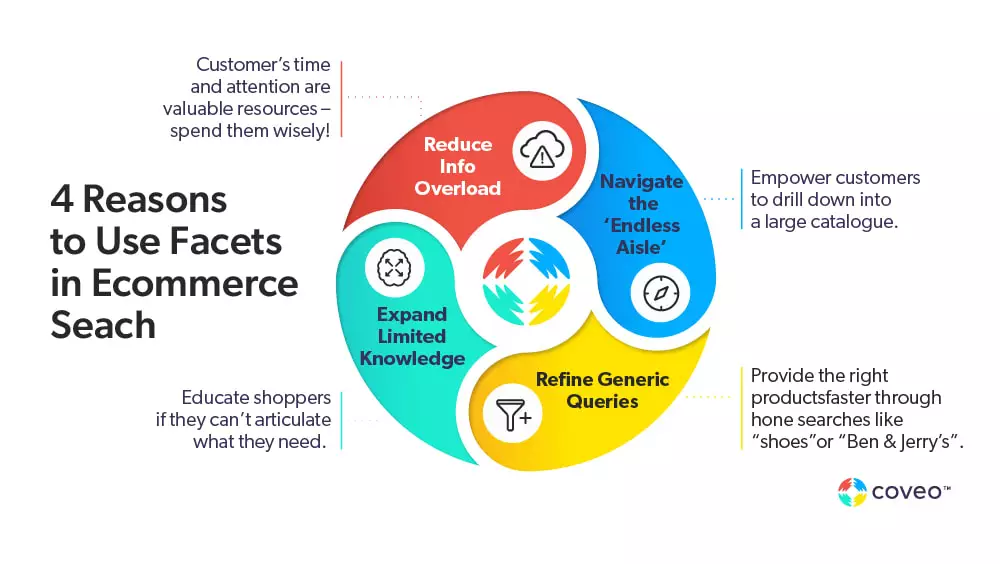
Incorporating faceted search into your website yields several compelling advantages:
- Streamlined Search Results: Faceted search simplifies the user’s search journey, enabling them to pinpoint exactly what they are looking for. This efficiency contributes to heightened engagement on your website.
- Attribute-Based Filtering: Users can fine-tune their search by filtering results based on brand name or product type attributes. This precision ensures that users find the specific items they seek quickly, eliminating the need to sift through irrelevant outcomes.
- Guidance for Indecisive Users: Faceted search caters to users needing a clearer idea of their desired product. Narrowing down results within a broader category allows even uncertain visitors to locate relevant options swiftly.
- Enhanced User Experience: The implementation of faceted search enhances the overall user experience by expediting the discovery of relevant products or services. Visitors can efficiently explore a wide array of offerings without investing excessive time.
- Comprehensive Display of Offerings: Faceted search allows for the detailed presentation of a diverse range of products or services, showcasing their specific attributes. This transparency ensures that users can make informed decisions.
Integrating faceted search into your website improves the overall user experience and elevates user engagement. Understanding the best practices of faceted search can guide you in implementing this feature effectively.
Faceted search is a dynamic tool, empowering users to refine their search results and locate precisely what they seek. In this blog post, we delve into the best practices of faceted search, unraveling its nuances to facilitate an intuitive and practical user experience.
Approaches to Faceted Saerch in Ecommerce:
1. Providing Basic Filter Options for Enhanced User Experience:
When it comes to optimizing an online shopping experience, the implementation of diverse filters is crucial. However, the key lies not just in quantity but in strategic organization. Start by offering fundamental, basic filters to your users before delving into more specific subcategories. A well-structured faceted search can significantly enhance user navigation and satisfaction.
Take Amazon, for instance, where their pricing facet exemplifies this principle:
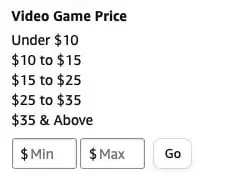
By incorporating options like “Under $10” and “$10 to $15,” Amazon simplifies the search process, saving users valuable time. Price ranges, as facets, cater to varied budget considerations, assisting users in finding products within their preferred spending limits.
2. Keeping Visitor Needs and Interests at the Forefront:
In the quest for a seamless user experience, understanding and addressing customer needs and interests is paramount. The art of faceted search involves offering relevant options without overwhelming potential customers with unrelated details. Zara’s faceted search for T-shirts stands out as an exemplary model:
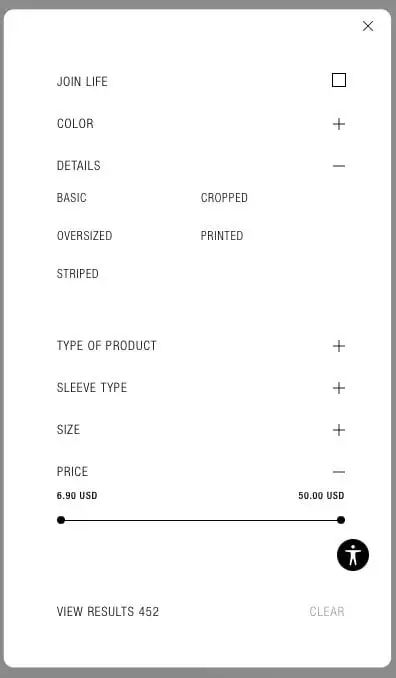
Here, sorting options encompass vital categories such as color, details, product type, sleeve type, size, and price. Zara strategically organizes these facets, allowing users to navigate through a wide range of T-shirts effortlessly. Subcategories, like “details,” further refine choices, presenting options like basic, cropped, oversized, printed, and striped.
For instance, if a visitor seeks a white striped T-shirt with long sleeves, Zara’s faceted search efficiently guides them to the desired products. The user-friendly interface facilitates easy navigation, enhancing the overall shopping experience.
Thematic filters, especially during special occasions like holidays, add an extra layer of personalization to elevate user engagement and satisfaction.
Learn about ecommerce automation here.
3. Striking the Right Balance with Facet Options:
While offering a variety of facets is essential, finding the right balance is equally critical. Striking a balance involves providing enough facets to aid users in their search without overwhelming them with an excess of options. Competitor research is a valuable tool to gauge user expectations and refine your approach.
Consider the example of IKEA, which skillfully incorporates five options on their wardrobe page:

Basic categories such as functions, price, size, colors, and sort contribute to a well-rounded research experience. The inclusion of pertinent facets streamlines the user’s journey, offering a balanced selection without inundating them with unnecessary choices. This approach ensures that users can navigate with ease, resulting in a more satisfying and efficient online shopping experience.
4. Enhancing User Experience through Popular Facet Sorting:
Strategically sorting facets based on their popularity is a pivotal step towards optimizing user experience and effectively reaching your target audience. Unlike relying on alphabetical order, which may not always align with user preferences, prioritizing popular categories can significantly impact engagement and conversion rates.
Consider the scenario where an unpopular category occupies the top spot – users may lose interest or struggle to find what they are looking for. Understanding your target audience enables you to identify the products they frequently seek. By showcasing popular categories prominently, you captivate user attention, increasing the likelihood of driving sales and meeting customer expectations.
5. Elevating User Choice with Multi-Select Options:
In the realm of filtering sections, the inclusion of multi-select options proves to be a game-changer. Allowing users to choose multiple options enhances their chances of making a purchase by providing a more tailored and efficient search experience.
Take H&M’s faceted search for dresses as an illustrative example:
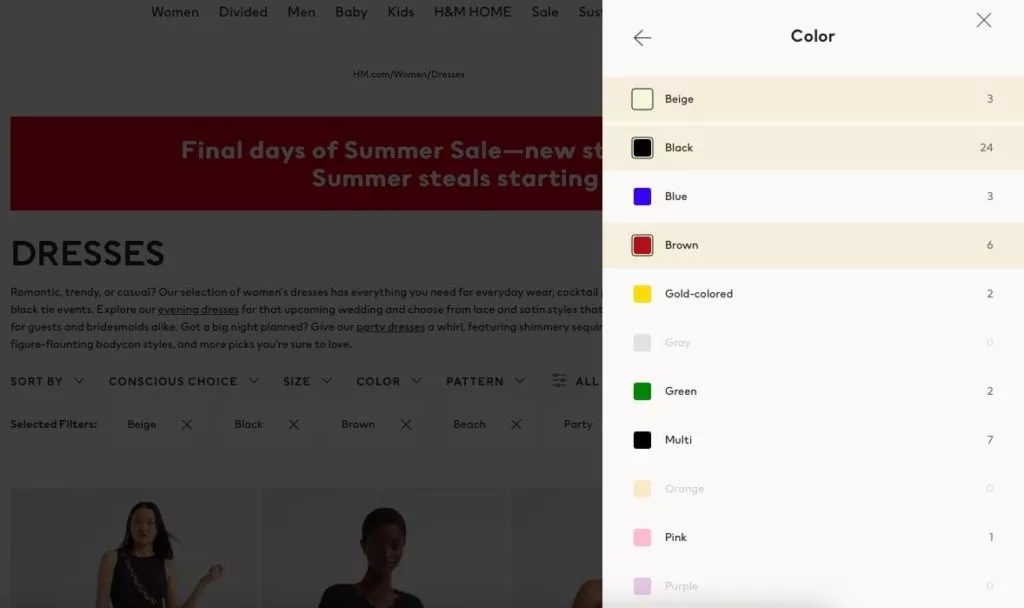
Within this navigation, users can simultaneously explore dresses in various colors like beige, black, and brown. H&M goes the extra mile by associating colors with names, displaying product numbers, and offering users the flexibility to choose more than one color. This approach not only streamlines the search process but also empowers users to consider different options for a specific product, fostering a more personalized shopping journey.
6. Highlighting Catalog Extensiveness through Product Count Display:
Showcasing the number of products within a facet reinforces the perception of an extensive catalog, instilling confidence in users that they can find precisely what they’re searching for. An exemplary instance is Sephora’s faceted search:

In their makeup category, facets like face, eye, lip, cheek, value & first sets are accompanied by the number of products within each category, presented in parentheses. This not only serves as an indicator of the product variety but also guides users towards sections with a more comprehensive selection.
7. Seamless Facet Placement for User-Friendly Navigation:
The arrangement of facets plays a crucial role in the overall user experience, and it is vital to strike a balance that complements the page layout without overwhelming visitors. Examining Pipcorn’s product pages illustrates this concept:
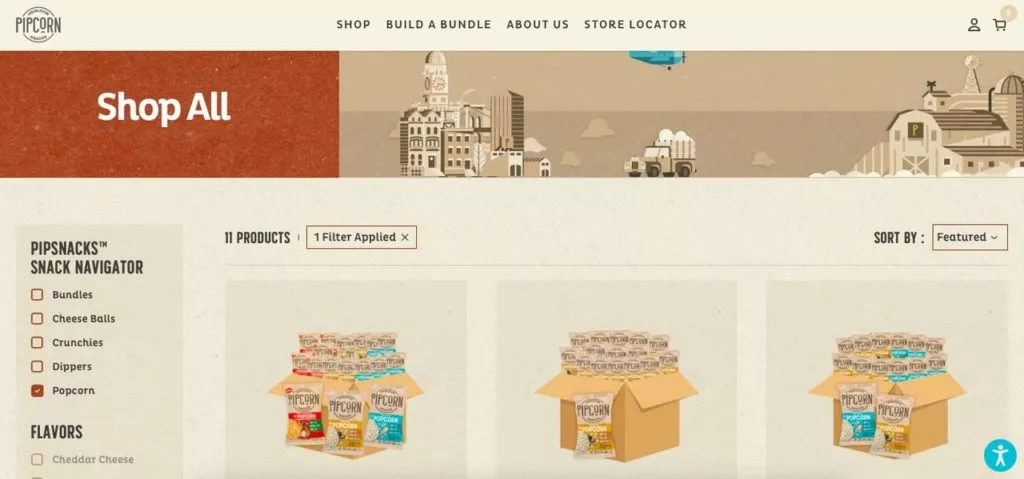
Pipcorn seamlessly integrates their faceted navigation with the product page, ensuring a cohesive visual experience. Applied filters are conveniently displayed below, allowing users to modify or add filters swiftly. Additionally, a ‘sort by’ section at the top facilitates sorting products based on various criteria, enhancing user convenience.
8. Prudent Handling of Facets with No Results:
Maintaining the relevance of your faceted search is critical to user satisfaction. A key aspect is steering clear of facets that yield no results, ensuring users are presented with meaningful options. Examining NYX Cosmetics’ pricing facet showcases the importance of thoughtful implementation:
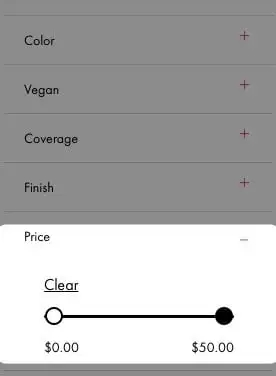
In this example, starting the pricing facet from $0.00 might lead to no results when a user selects $4, as the cheapest product is $5. A more user-friendly approach, as demonstrated by La Roche Posay:

Here, the pricing facet starts from $8.00, aligning with the actual product range and preventing instances of ‘no results.’ This proactive approach enhances user experience and ensures that facets consistently provide valuable and relevant options.
9. Tailoring Faceted Navigation for Seamless Desktop and Mobile Experiences:
In the dynamic landscape of web design, it’s imperative to craft faceted navigation that seamlessly adapts to both desktop and mobile interfaces. The one-size-fits-all approach might not be optimal, considering the distinctive attributes of each platform. Striking a balance and acknowledging the differences between desktop and mobile designs is crucial for an enhanced user experience.
Desktop functionality allows for instantaneous page refreshes, swiftly presenting results upon the selection of a new filter. Nike’s desktop faceted search serves as a notable example:

Designed for larger screens, the desktop version maintains a user-friendly experience, ensuring that the page refreshes with each facet selection without significantly affecting the user’s journey.
Conversely, the mobile interface necessitates a different strategy. Nike’s mobile faceted search, tailored for smaller screens, opts for a more user-centric approach:
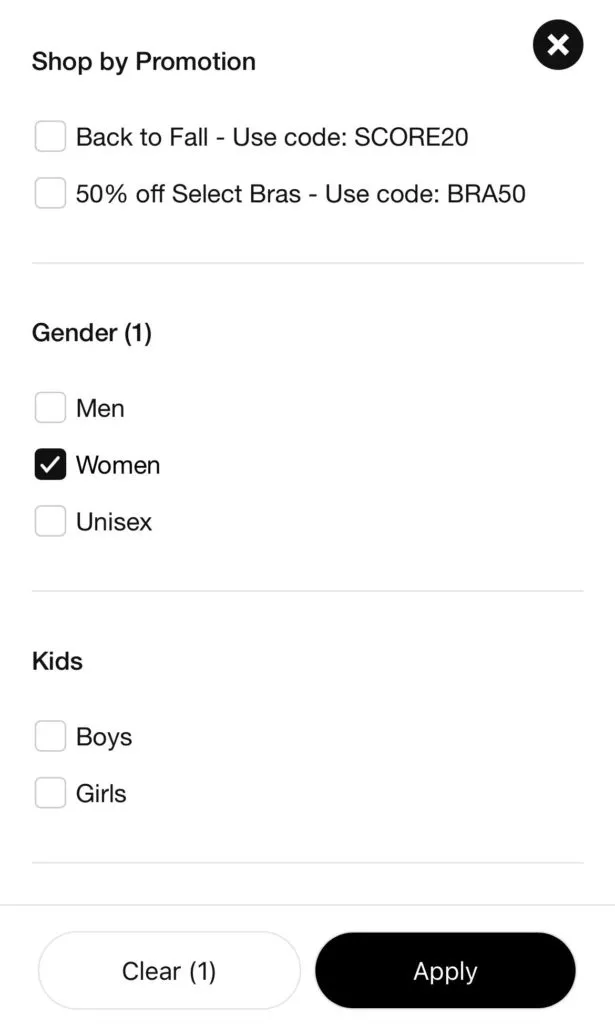
Unlike desktop, the mobile version refrains from refreshing the page with every facet selection. Instead, it provides users with the flexibility to choose, clear options, and then apply changes, enhancing mobile users’ interaction with the faceted navigation feature.
Wrap Up:
In conclusion, implementing a faceted search feature requires meticulous consideration and adherence to best practices. By incorporating the nine guidelines outlined in this blog post and drawing inspiration from the provided examples, you can refine your website’s faceted navigation. Always prioritize customer satisfaction, particularly in instances where your website offers an extensive catalog or diverse service options.
Faceted filters, when appropriately developed, act as a shield against overwhelming visitors with a multitude of options. Instead, users can tailor their search experience by selecting various options aligned with their needs and interests.
Elevating your faceted search section not only improves user engagement but also has the potential to boost sales. A satisfied visitor often transforms into a loyal customer, underscoring the continuous need to enhance and optimize your website for an elevated user experience.
FAQs on Faceted Search:
- What is a Multifaceted Search?
A multifaceted search allows users to explore information based on multiple criteria. It enables users to filter results by various parameters, such as type, color, and material, providing an organized and nuanced search experience. - What are the Popular Facets?
Popular facets can vary based on the products or services offered. However, some commonly sought-after facets include product ratings and reviews, brands, age or size, color and style, as well as pricing details or ranges. - Difference between Filter and Facet?
Facets and filters both aid in narrowing down searches, but they have nuanced distinctions. Facets group data into logical categories, allowing users to apply multiple options. Filters, on the other hand, are broader and often set before the search, providing main categories without the flexibility of multiple selections.



